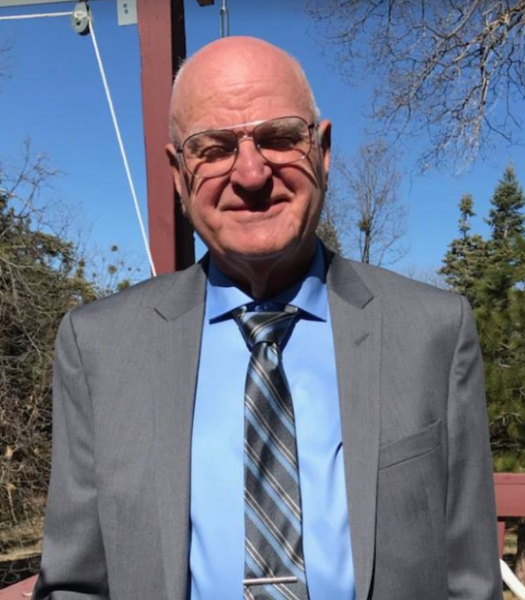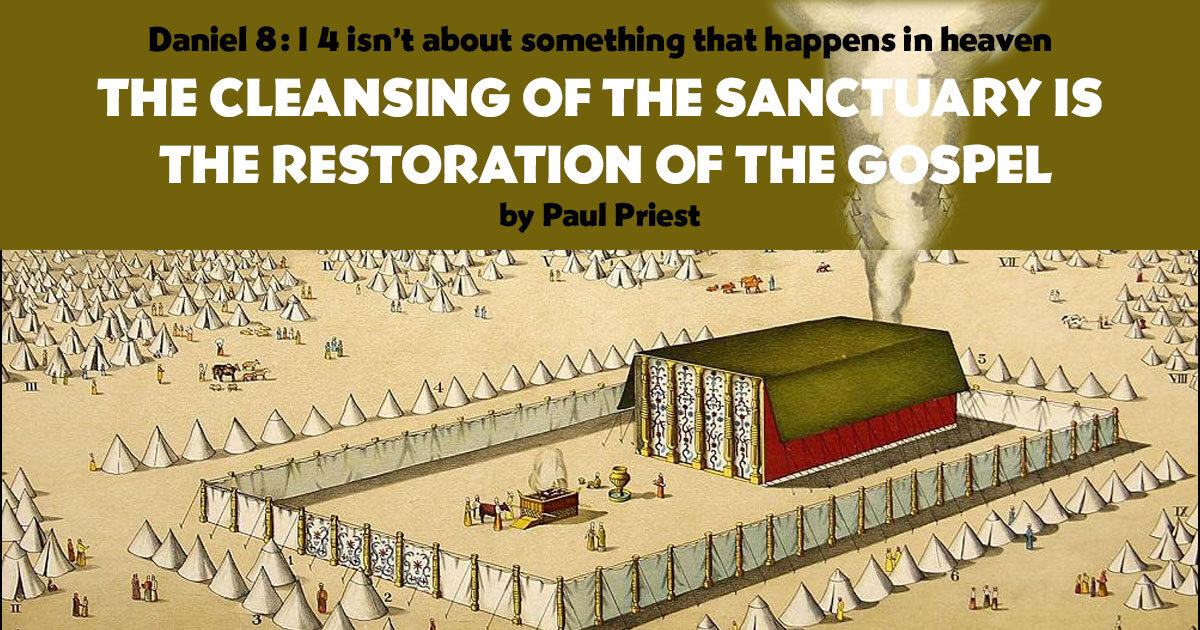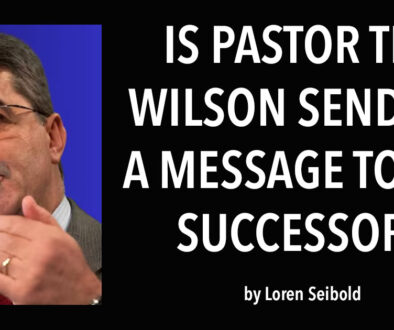Daniel 8:14 Is About Restoring the Gospel of God’s Grace
by Paul Priest | 1 May 2025 |
And he said unto me, “Unto two thousand and three hundred days; then shall the sanctuary be cleansed.” Daniel 8:14 KJV
“You must lay your preconceived…opinions at the door of investigation. If you search the Scriptures to vindicate your own opinions, you will never reach the truth.” Christ’s Object Lessons, p. 112
Controversy has existed in the church almost from the beginning over the interpretation of Daniel 8:14. The first challenge was in 1887 by Dudley M. Canright. About every 20 years thereafter, someone has pointed out flaws in the church’s interpretation of this text.
What has been consistent is the church’s response: any minister who questions the authenticity of the traditional interpretation of Daniel 8:14 is pushed out. This implies that the interpretation of this text has been especially attacked by Satan. What is it about this text that Satan doesn’t want us to understand?
I believe Daniel 8:14 is something quite different than our pioneers said it is. I propose it is a promise of a restored gospel message, to occur at the time of the end, with the result of the indwelling of the Holy Spirit in believers.
The traditional interpretation
William Miller, who was part of the second great religious awakening in America, adopted the view that the earth was the sanctuary. He interpreted the cleansing of the sanctuary as the cleansing of the earth, which would occur at the second coming of Christ on October 22, 1844.
Of course, that didn’t happen. We call it The Great Disappointment. The mistake of the early Adventists “was in accepting the popular view that the earth was the sanctuary” (The Great Controversy, p.352).
Hiram Edson—according to tradition, while passing through a field—said he had seen Christ come out of the holy place of the heavenly sanctuary and enter the most holy place. During the next several months Hiram Edson, O.R.L. Crosier, and F. B. Hahn studied the sanctuary service recorded in Exodus, Leviticus, and Hebrews to understand Christ’s work in the heavenly sanctuary.
The sanctuary service
In the original service, a sinner brought a lamb to the sanctuary and confessed his sin on the head of the lamb. The lamb was sacrificed, and blood from the lamb was taken by the priest into the sanctuary and sprinkled on the veil that separated the Holy Place from the Most Holy Place. This action symbolically transferred the sinner’s sin to the sanctuary. Once a year, on the day of atonement, the sanctuary was cleansed of confessed sins.
Crosier wrote up the group’s conclusions, suggesting that something parallel happened in heaven on October 22, 1844. He published it in the DayStar Extra of Feb. 7, 1846. His premise was that the sanctuary that Daniel said would be cleansed was the heavenly sanctuary, and that the cleansing was the removal of the confessed sins of the saints. James White reprinted this view in the Advent Review of September 1859. It was endorsed by Ellen White and eventually became Fundamental Belief #24. (For more information, see the Seventh-day Adventist Bible Commentary, Vol 4, pp.60-70).
Interpretive problems
This cleansing idea allowed the pioneers to move past the disappointment and establish the Adventist church. It is foundational to Adventism—but it is not without problems.
According to Daniel 8:11,12, the sanctuary is defiled and cast down by the little horn of Daniel 8. The pioneers identified the little horn as Rome, in its political and papal forms.
But if it is the sins of the saints that defile the sanctuary—according to the traditional interpretation—then the saints would have to be the little horn! Presenting the cleansing of the heavenly sanctuary as the fulfillment of Daniel 8:14 contradicts the context of verses 11 and 12. On this contextual basis, the traditional view is incorrect.
The pioneers’ interpretation was based on the King James Version of the Bible. It contains several mistranslations. For example, the Hebrew word tsadaq translated as “cleansed” in the KJV actually means “made right” or “restored.” The NASB (2020 edition) reads “For 2,300 evenings and mornings; then shall the sanctuary be properly restored.” The NIV, NET, ESV, and RSV all say either “restored” or a synonym.
Cleansed and restored carry quite different meanings. Cleansed implies the removal of something—in the traditional interpretation, the sins of the saints. Restored means making something right again. I believe a better understanding is that God makes right not an esoteric event in heaven, but a restoration of the truth of the gospel.
So what Crosier published in the DayStar was an incorrect exegesis of Daniel 8:14. Daniel 8:14 is prophesying the restoration of the gospel of grace as taught by Jesus.
The earthly sanctuary was patterned after the sanctuary in heaven (Exodus 25:8,9)—and its intention was to model the gospel. Hebrews 4:2 says “the gospel was taught to them (Israel) as well as to us.” The sanctuary service was a visual show-and-tell of the gospel. “Thy way [of salvation, gospel], O God, is in the sanctuary” Psalm 77:13 KJV. The lamb symbolizes Christ. The sin confessed on the head of the lamb symbolized the transfer of the sin to Christ. The sacrifice of the lamb foreshadowed His death on the cross. The sin was carried by the blood of Christ to the heavenly sanctuary.
The little horn flung this truth to the ground (Daniel 8:12) by substituting confession to a priest rather than to Christ. Only Christ can forgive sin; this fact of the gospel was taught by the sanctuary.
As for 2 Thessalonians 2:3-7, it addresses an apostasy which was taking place in the early Christian church in Paul’s day. He calls it a “falling away.” As a result of this falling away, the central truths of the gospel were cast down (Anderson, 105).
“When the early church became corrupted by departing from the simplicity of the gospel and accepting heathen rites and customs, she lost the Spirit and power of God….” (The Great Controversy, p. 443).
The seven churches of Revelation 2-3 demonstrate this progression of falling away.
What is the sanctuary?
Ellen White asserts, “This [the earthly sanctuary] is the only sanctuary that has ever existed on the earth, of which the Bible gives information” (The Great Controversy, p.512).
In this, I believe she was wrong; there is another:
1 Cor 3:16 “Do you not know that you are a temple of God, and that the Spirit of God dwells in you?” NASB
1 Cor 3:17 “If anyone destroys the temple of God, God will destroy that person, for the temple of God is holy, and that is what you are.” NASB
1 Cor 6:19 “Do you not know that your body is a temple of the Holy Spirit within you, whom you have from God, and that you are not your own?” NASB
2 Cor 6:16 “What agreement does the temple of God have with idols? For we are the temple of the living God, just as God said.” NASB
The pioneers didn’t identify the human temple! I find no evidence in the literature that it was even considered. Edson’s epiphany locked their thinking onto the heavenly sanctuary.
What Edson actually saw is not clear, other than Christ going from the Holy Place to the Most Holy. Because of this misinterpretation they focused on the cleansing of the sanctuary, not on a careful exegesis of the text. Did Edson see in vision Christ removing the sins of the saints, or is this interpretation the conclusion of their Bible study? We don’t know—though we do know that it took many years for the doctrine to take its form as it is generally used today.
The gospel of grace
The sanctuary model reveals the whole plan of salvation from its beginning to its end. It describes Christ’s work in the heavenly sanctuary, but it mainly describes His work in the human sanctuary—in your life and mine.
The little horn’s attack on the sanctuary was an attack on the gospel, God’s plan of salvation. Why attack the gospel? Because “it is the power of God for salvation to everyone that believes” (Romans 1:16). The purpose of the gospel is to save us and to restore the divine image in us. By attacking the gospel he was attacking God’s work in the human temple.
I am suggesting that the restoration of the sanctuary of Daniel 8:14 means that after 1844, the understanding of the gospel of salvation by faith in Jesus should be restored to believers, and the Holy Spirit again indwell the human temple.
In Revelation 14:6,7, the first angel announces the preaching of the everlasting gospel, the beginning of the judgment, and the worship of God as creator. All three begin following 1844, just as prophesied. The judgment was presented by the Millerite movement. The call to worship God as creator began with the restoration of the seventh-day sabbath memorial of creation (Exodus 20:11) in 1846.
And at last the gospel was also presented to Adventists, in the 1888 message of Waggoner and Jones.
A restored gospel
Belief in and obedience to the gospel restores the Holy Spirit to the human temple. The purpose of the gospel has always been to save us and restore the divine image in us.
Based upon its context, I believe Daniel 8:14 addresses a restored gospel. It is not about the removal of the sins of the saints from a place in heaven—that interpretation makes the saints the little horn. Instead, it is a promise of a restored gospel that results in the indwelling Holy Spirit who imparts the character of Christ to the believer, and collectively the church.
What Edson, Crosier, and Hahn discovered in their study of Exodus, Leviticus, and Hebrews was the gospel as taught by the sanctuary—though they apparently didn’t know it at the time.
Works Referenced
Anderson, Roy. Unfolding Daniel’s Prophecy. Mountain View, CA: Pacific Press Pub. Assn., 1975.
Editor, Francis D. Nichol. SDA Bible Commentary vol 4. Washington, DC: Review and Herald Pub., 1955.
Sequeira, Jack. Beyond Belief. Berrien Springs, MI: Glad Tidings Pub., 2016.
White, Ellen G. Early Writings. Washington, DC: Review and Herald Pub., 1882.
White, Ellen. The Great Controversy. Deland, Florida: Laymen for Religious Liberty, 1990.
Jones A.T. The Consecrated Way to Christian Perfection. Berrien Springs, MI: Glad Tidings Publishers, 2017
 Paul Priest earned an Ed.D. from Loma Linda University with emphasis in science education. He taught for 22 years in Adventist academies, and 22 years in public school. He lives in southern California.
Paul Priest earned an Ed.D. from Loma Linda University with emphasis in science education. He taught for 22 years in Adventist academies, and 22 years in public school. He lives in southern California.
To comment, click/tap here.




